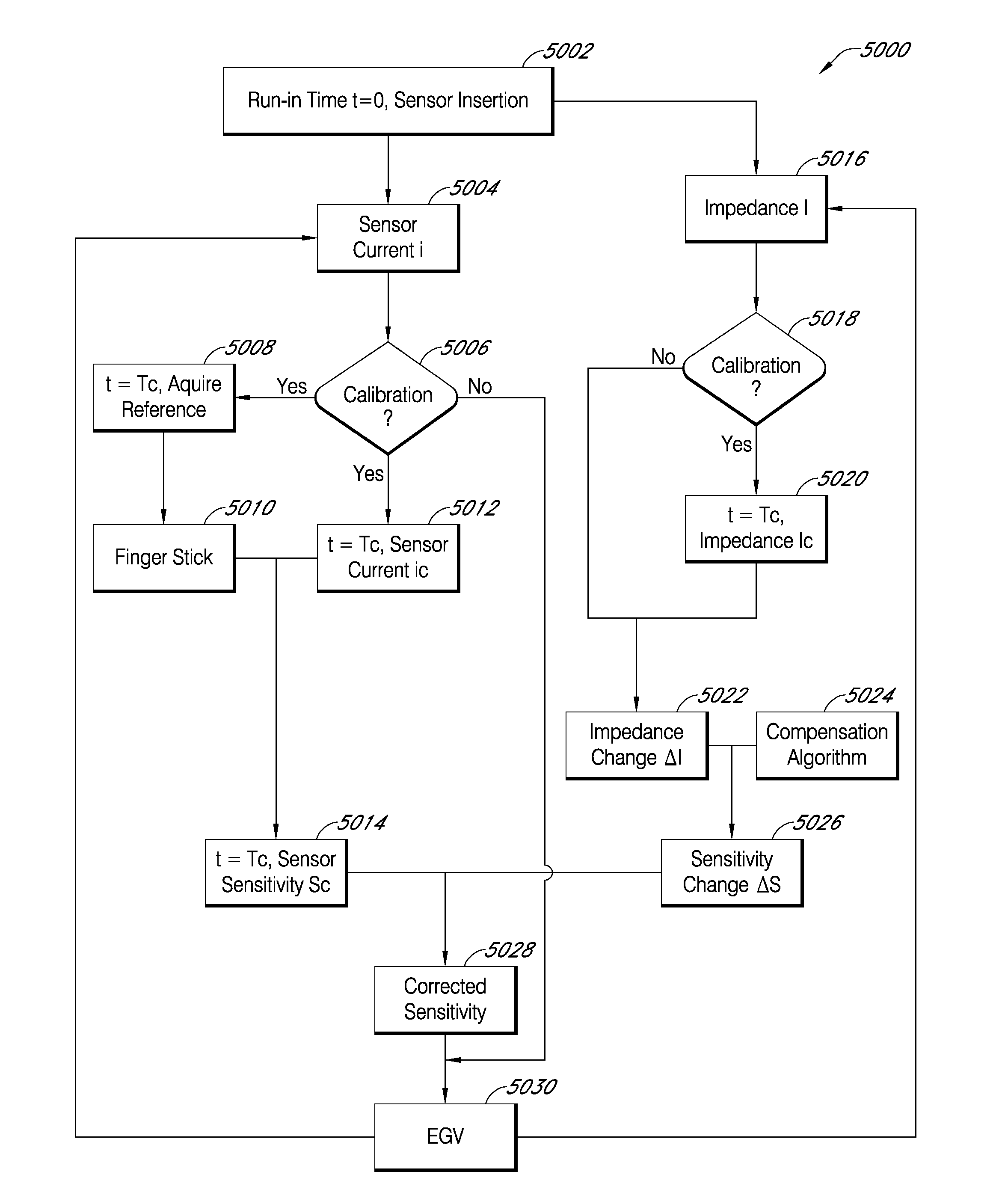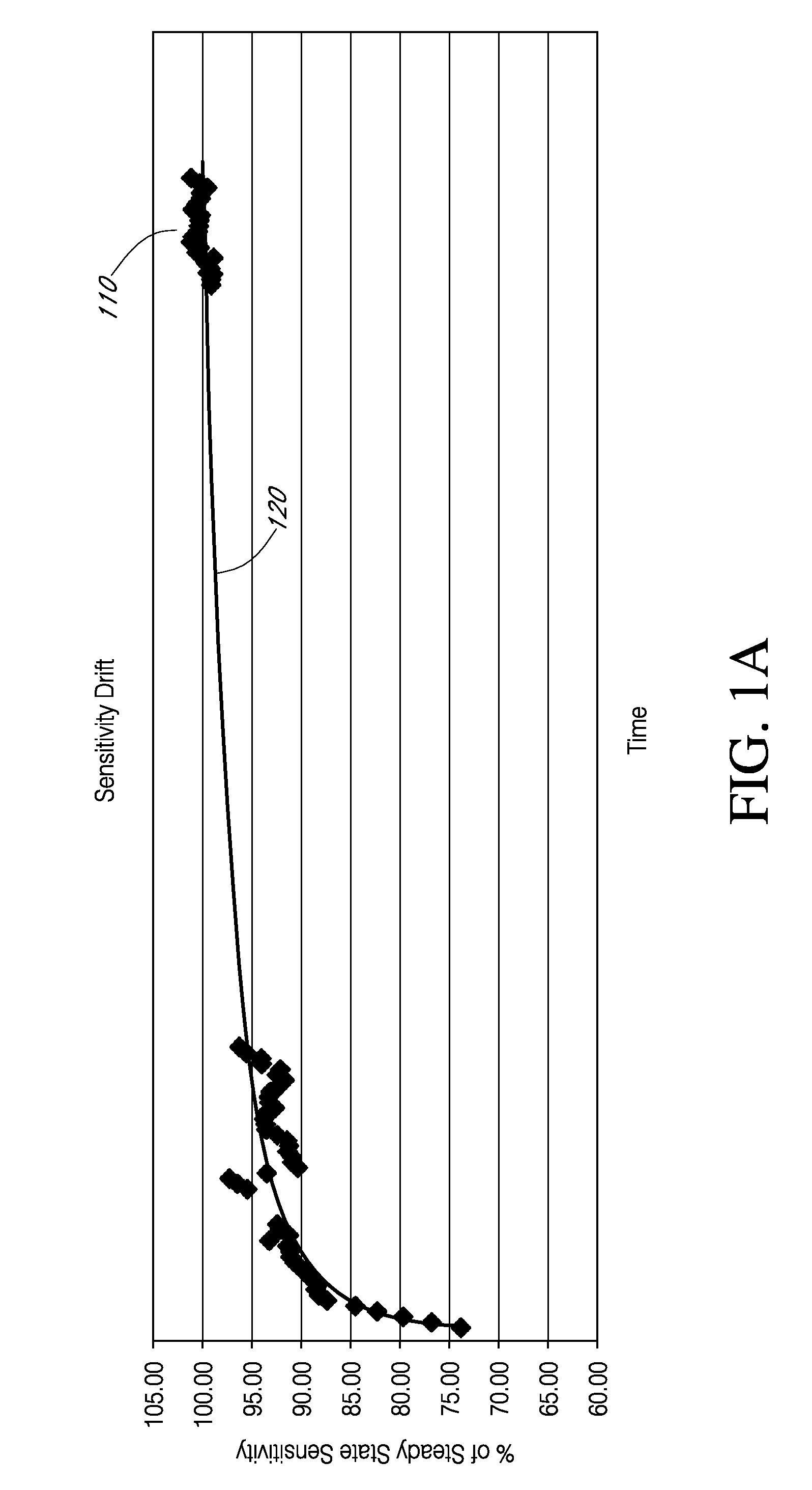Advanced analyte sensor calibration and error detection
- Summary
- Abstract
- Description
- Claims
- Application Information
AI Technical Summary
Benefits of technology
Problems solved by technology
Method used
Image
Examples
example 1
Sensitivity and Impedance Relationship
[0433]Example 1 illustrates a relationship between sensitivity of a sensor and an impedance of the sensor. In this example, an IVBG sensor was connected to a Gamry potentiostat system and placed in a in a buffer solution of a modified isolyte having a glucose concentration of 100 mg / dL. The temperature during the experiment was 37 C. An impedance spectrum was captured at fixed intervals of time. The impedance spectrum analyzed in this experiment ranged from 1 Hz to 100 kHz and measurements of the sensor impedance and sensor sensitivity were taken at 15 minute intervals over a period of about 1200 minutes.
[0434]Reference is now made to FIG. 25, which is a graph showing absolute values of sensitivity and impedance of the sensor based on an input signal having a frequency of 1 kHz. Data points 2502 represent measured values of sensor sensitivity over a time period of 1200 minutes (20 hours), where t=0 corresponds to the time when the sensor is init...
example 2
Retrospectively Compensating for Sensitivity Drift Using Impedance
[0437]FIG. 27 is a plot of sensitivity and impedance points measured at various intervals over time using seven different sensors, Sensors A-G. Sensors A-G were transcutaneous-type sensors, but selected from several different sensor lots. Thus, even though Sensors A-G were all transcutaneous sensors, sensors from different lots may have been made in a slightly different way or under slightly different conditions, which can result in sensors from different lots exhibiting different sensitivity profiles. In this Example, Sensors A and D were selected from a first lot, Sensor B was selected from a second lot, and Sensors C, E, F and G were selected from a third lot.
[0438]Further to FIG. 27, the plotted data points are sensitivity and impedance values for each Sensor A-G. Because the sensitivity of each Sensor A-G gradually increases over time, the right most points of each Sensor's plotted data points tend to correspond ...
example 3
Prospective Calibration of Sensor Data Using Impedance Measurements
[0447]Example 5 pertains to prospective calibration. Further, in this experiment, calibration of sensor data is based on a change of sensitivity to change in impedance relationship previously derived from sensors from a different sensor lot. That is, in Example 3, the estimative curve 2802 is used to compensate data obtained using Sensors R-U, each of which was selected from a fourth sensor lot, the fourth sensor lot was not included in the group of sensors used to derive the estimative curve 2802. Example 5 shows that data can be calibrated using a change in sensitivity to change in impedance relationship derived from different sensor types than the type of sensor being calibrated. This can indicate that a sensor factory calibration code need not be used to compensate for sensitivity drift.
[0448]FIGS. 35 and 36 illustrate prospectively calibrating sensor data obtained from Sensors R-U. FIG. 35 is a plot of the perce...
PUM
 Login to View More
Login to View More Abstract
Description
Claims
Application Information
 Login to View More
Login to View More - R&D
- Intellectual Property
- Life Sciences
- Materials
- Tech Scout
- Unparalleled Data Quality
- Higher Quality Content
- 60% Fewer Hallucinations
Browse by: Latest US Patents, China's latest patents, Technical Efficacy Thesaurus, Application Domain, Technology Topic, Popular Technical Reports.
© 2025 PatSnap. All rights reserved.Legal|Privacy policy|Modern Slavery Act Transparency Statement|Sitemap|About US| Contact US: help@patsnap.com



